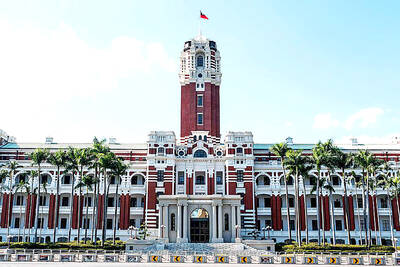Some of the world's brightest technologists hail from this south Indian city, burnishing Bangalore's reputation as the Silicon Valley of the East.
Yet for most Indians, whose average income is US$450 a year, a computer is a foreign word. Ownership is a distant dream.

PHOTO: AP
A group of seven Indian computer scientists think they can help.
They've built a simple, inexpensive handheld computer -- they call it the Simputer -- that in the words of co-developer Vinay Deshpande "could truly take the benefits of information technology to the underserved of the world."
Fewer than 1 percent of India's more than 1 billion people have personal computers.
More than 40 percent of the population is illiterate, and one in four Indians lives in abject poverty.
The idea for the Simputer, which is slated for launch by year's end, emerged from the India Institute of Science and Encore Software Ltd after both were asked by the government to devise ways to deliver information technology's benefits to rural India, where some 75 percent of the country's population lives.
Inspired by the transistor radio, which opened an information spigot to India's villages in the 1970s, the team designed a 7.5cm by 12.5cm telecommunications-ready machine.
They envision Indian farmers using it to get on the Internet via public telephones and check produce prices, government tax and land records.
Although it was designed with Indians in mind, the hope is that the Simputer will be attractive to governments, banks, relief agencies and schools in other developing countries.
"It is a big boost for Indian pride," said Deshpande, the chairman of Encore Software, one of two companies that hold the manufacturing license.
"It proves what we've been saying all along: That we can do it here. This is 100 percent India."
Swami Manohar, another of the developers and a computer science professor at IIS, said the Simputer's initial price would be around US$320. Eventually, they intend to sell it in volume at US$190.
That's still expensive for most Indians.
So the Simputer would accommodate smart cards, which each cost about US$4.25. That would enable farmers, villages or schools to share a single device, and use individual smart cards to store data.
The Simputer runs on a version of the Linux operating system, whose source code is free on the Internet. It has a 320-by-240-pixel monochrome display, is powered by a 200Mhz StrongArm processor and has a hard polymer shell.
The current prototype has 32MB of random access memory, runs on three AAA nickel metal hydride batteries, includes a built-in speaker, a microphone and a telephone jack, and USB and smart card connectors. Into the software bundle are a built-in Internet browser, e-mail program, MP3 player and a modem.
Because it runs on Linux, programmers working through the nonprofit Simputer Trust can improve on the machine's codes and capabilities. On their Web site, the developers say the trust aims to promote the Simputer "as an evolving platform for social change.''
Since many of its users would be illiterate, the Simputer has text-to-speech capability and voicemail.
It is designed to break down written words into basic sounds, then put them back together and speak out in English, Hindi, Tamil and Kannada.
Users can also enter text on a soft screen keyboard, one character at a time, or with a stylus using a handwriting recognition program the designers call "Tapatap"' -- (akin to Graffiti in the Palm OS).
The Simputer Trust does not intend to manufacture the device, only license its design. It plans to charge US$25,000 to commercial producers in developing countries and US$250,000 to manufacturers in developed nations.
"This is a world-class product, ahead of anything being done anywhere else in the world," said Kenneth Keniston, director of the India Program at the Massachusetts Institute of Technology.
The Simputer is not, however, the only cheap computer out there.
In Brazil, computer scientists at Federal University of Minas Gerais have developed a prototype of a PC for the people -- dubbed the Volkscomputer -- which they envision will sell for US$300.
But it's not portable, making it more difficult to share among communities.
The Simputer's developers scrounged for grants and credit the university for giving them lab space and research and development time.
And they don't pretend they don't hope to get rich off the Simputer one day.
The men who built the handheld put in much of their own time and money, and the four computer scientists at the Indian Institute of Science, considered the MIT of the East, earn some US640 monthly and have put most of their other research on hold.
"Not to mention that we haven't seen our families," said V. Vinay, one of the professors. "We're not looking at the retail market, but we're not going to ignore it either."
Deshpande, the software and marketing man of Simputer, agrees: "We hope to make money in the long run."

The CIA has a message for Chinese government officials worried about their place in Chinese President Xi Jinping’s (習近平) government: Come work with us. The agency released two Mandarin-language videos on social media on Thursday inviting disgruntled officials to contact the CIA. The recruitment videos posted on YouTube and X racked up more than 5 million views combined in their first day. The outreach comes as CIA Director John Ratcliffe has vowed to boost the agency’s use of intelligence from human sources and its focus on China, which has recently targeted US officials with its own espionage operations. The videos are “aimed at

STEADFAST FRIEND: The bills encourage increased Taiwan-US engagement and address China’s distortion of UN Resolution 2758 to isolate Taiwan internationally The Presidential Office yesterday thanked the US House of Representatives for unanimously passing two Taiwan-related bills highlighting its solid support for Taiwan’s democracy and global participation, and for deepening bilateral relations. One of the bills, the Taiwan Assurance Implementation Act, requires the US Department of State to periodically review its guidelines for engagement with Taiwan, and report to the US Congress on the guidelines and plans to lift self-imposed limitations on US-Taiwan engagement. The other bill is the Taiwan International Solidarity Act, which clarifies that UN Resolution 2758 does not address the issue of the representation of Taiwan or its people in

US Indo-Pacific Commander Admiral Samuel Paparo on Friday expressed concern over the rate at which China is diversifying its military exercises, the Financial Times (FT) reported on Saturday. “The rates of change on the depth and breadth of their exercises is the one non-linear effect that I’ve seen in the last year that wakes me up at night or keeps me up at night,” Paparo was quoted by FT as saying while attending the annual Sedona Forum at the McCain Institute in Arizona. Paparo also expressed concern over the speed with which China was expanding its military. While the US

SHIFT: Taiwan’s better-than-expected first-quarter GDP and signs of weakness in the US have driven global capital back to emerging markets, the central bank head said The central bank yesterday blamed market speculation for the steep rise in the local currency, and urged exporters and financial institutions to stay calm and stop panic sell-offs to avoid hurting their own profitability. The nation’s top monetary policymaker said that it would step in, if necessary, to maintain order and stability in the foreign exchange market. The remarks came as the NT dollar yesterday closed up NT$0.919 to NT$30.145 against the US dollar in Taipei trading, after rising as high as NT$29.59 in intraday trading. The local currency has surged 5.85 percent against the greenback over the past two sessions, central